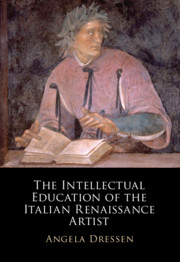Book contents
- The Intellectual Education of the Italian Renaissance Artist
- The Intellectual Education of the Italian Renaissance Artist
- Copyright page
- Contents
- Illustrations
- Preface
- Introduction
- One Mechanical Arts versus Liberal Arts and Recommendations for the Artist’s Education
- Two Educational Places and Opportunities
- Three The Mediating Texts
- Four Vitruvius and Pliny as Sourcebooks, Educational Landmarks, and Intellectual Challenge
- Conclusion
- Book part
- Selected Bibliography
- Index
Three - The Mediating Texts
Published online by Cambridge University Press: 28 August 2021
- The Intellectual Education of the Italian Renaissance Artist
- The Intellectual Education of the Italian Renaissance Artist
- Copyright page
- Contents
- Illustrations
- Preface
- Introduction
- One Mechanical Arts versus Liberal Arts and Recommendations for the Artist’s Education
- Two Educational Places and Opportunities
- Three The Mediating Texts
- Four Vitruvius and Pliny as Sourcebooks, Educational Landmarks, and Intellectual Challenge
- Conclusion
- Book part
- Selected Bibliography
- Index
Summary
The long-lasting affinity between painting and literature has been documented in many ways (see Chapter 1). Following either the discussion about whether literature or the visual arts had an academic standing or the related but separately led discussion after Horace’s ut pictura poiesis about whether painting should be done like poetry, authors acknowledged that painting and literature had a lot in common. Cristoforo Landino, Angelo Poliziano, and members of the Florentine literary academy, like Benedetto Varchi and Giambattista Gelli, saw painters and poets on the same intellectual level and underlined their symbiosis.1 And a multitude of authors, most of all Alberti, recommended that the painters orient themselves in relation to literature.2 Without a doubt, the majority of paintings had an iconography deriving from biblical or classical sources that were sometimes transformed in modern interpretations. That these sources were not beyond the reach of Renaissance painters was demonstrated in Chapter 2. The predominant question remains: How did a painter gain access to a source?
- Type
- Chapter
- Information
- The Intellectual Education of the Italian Renaissance Artist , pp. 133 - 282Publisher: Cambridge University PressPrint publication year: 2021



